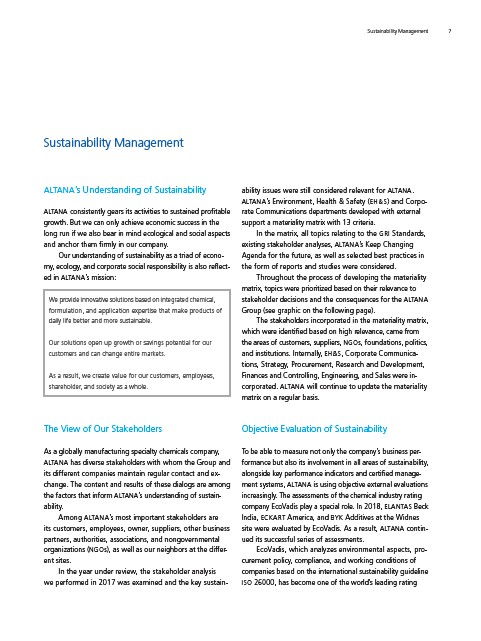
ALTANA’s Understanding of Sustainability
ALTANA consistently gears its activities to sustained profitable
growth. But we can only achieve economic success in the
long run if we also bear in mind ecological and social aspects
and anchor them firmly in our company.
Our understanding of sustainability as a triad of economy,
ecology, and corporate social responsibility is also reflected
in ALTANA’s mission:
We provide innovative solutions based on integrated chemical,
formulation, and application expertise that make products of
daily life better and more sustainable.
Our solutions open up growth or savings potential for our
customers and can change entire markets.
As a result, we create value for our customers, employees,
shareholder, and society as a whole.
The View of Our Stakeholders
As a globally manufacturing specialty chemicals company,
ALTANA has diverse stakeholders with whom the Group and
its different companies maintain regular contact and exchange.
The content and results of these dialogs are among
the factors that inform ALTANA’s understanding of sustainability.
Among ALTANA’s most important stakeholders are
its customers, employees, owner, suppliers, other business
partners, authorities, associations, and nongovernmental
organizations (NGOs), as well as our neighbors at the different
sites.
In the year under review, the stakeholder analysis
we performed in 2017 was examined and the key sustain-
ability issues were still considered relevant for ALTANA.
ALTANA’s Environment, Health & Safety (EH&S) and Corporate
Communications departments developed with external
support a materiality matrix with 13 criteria.
In the matrix, all topics relating to the GRI Standards,
existing stakeholder analyses, ALTANA’s Keep Changing
Agenda for the future, as well as selected best practices in
the form of reports and studies were considered.
Throughout the process of developing the materiality
matrix, topics were prioritized based on their relevance to
stakeholder decisions and the consequences for the ALTANA
Group (see graphic on the following page).
The stakeholders incorporated in the materiality matrix,
which were identified based on high relevance, came from
the areas of customers, suppliers, NGOs, foundations, politics,
and institutions. Internally, EH&S, Corporate Communications,
Strategy, Procurement, Research and Development,
Finances and Controlling, Engineering, and Sales were in-
corporated. ALTANA will continue to update the materiality
matrix on a regular basis.
Objective Evaluation of Sustainability
To be able to measure not only the company’s business performance
but also its involvement in all areas of sustainability,
alongside key performance indicators and certified management
systems, ALTANA is using objective external evaluations
increasingly. The assessments of the chemical industry rating
company EcoVadis play a special role. In 2018, ELANTAS Beck
India, ECKART America, and BYK Additives at the Widnes
site were evaluated by EcoVadis. As a result, ALTANA continued
its successful series of assessments.
EcoVadis, which analyzes environmental aspects, procurement
policy, compliance, and working conditions of
companies based on the international sustainability guideline
ISO 26000, has become one of the world’s leading rating
Sustainability Management
Sustainability Management 7